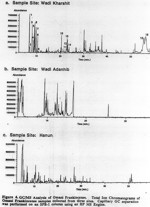The Archaeology Fund
The Chemistry of Incense
|
Both frankincense and myrrh belong to the family Burseraceae. The exuded resins in both cases contain a wide variety of terpenoids and polysaccharides, as well as a wide variety of secondary metabolites. As early as 1788 investigation began in the chemical makeup of frankincense. Early studies based their species identification on solubility testing, ash content and oil yields. By the 1930's chemical analyses were beginning to be made. The chemical characteristics of both frankincense and myrrh is determined by solubility in water and ethanol, oil yields and TLC/GC profiles. Thus we know that the chemical composition of these natural oleo-gum-resins includes a low percentage of essential oils, a very large percentage of alcohol-soluble resins, and the rest water-soluble resins. By 1980, more than 110 compounds were identified in the oil and resin fractions. Within the next five years, research identified over 250 compounds which were present in this family of plants. A basic differentiation is between those resins that contain volatile components and those that do not. Results of the volatile oil studies clearly divide species into two groups: monoterpene and sesquiterpene oil producers. Only frankincense oils contain both types. All myrrh types also contain sesquiterpenes. A pilot study in Dhofar also demonstrated the possibility that through GC profiles regional variation could be detected in frankincense resins. The problems in the past, however, have arisen when "trade" samples were submitted for analysis. The DRAGOCO studies suggested that a clear distinction existed between samples from Aden and Eritrea. However, these samples are a mixture of materials from unknown sources and species. hus, ‘commercial" mixtures could have resulted from both mixing species as well as regional source materials. However, careful chemical composition studies in the future will not only isolate different species of incense-producing trees, but will differentiate geographical and climatic variations in incense types, perhaps creating useful chemical fingerprints somewhat analogous to obsidian. Suggested research/readings: Basic chemistry on incense materials can be garnered from Dieter Martinetz, Karlheinz Lohs And Jorg Janzen, Weihrauch und Myrrhe. Berlin: Akademie verlag, 1989. Several chapters on the chemistry of incense and a fine bibliography are available. For a brief summary of Arabian frankincense and myrrh plants, see: Shahina Ghazanfar, Handbook of Arabian Medicinal Plants. 1994. Anthony Miller and Miranda Morris. Plants of Dhofar. 1988. Nigel Groom, Frankincense and Myrrh. Jose-Marie Bel and Theodore Monod Botanique au Pays de L'Ecens. 1995. Gordon J. Provan wrote his doctoral thesis on the chemical analysis of numerous African incense species. Obtain a copy from University of Strathclyde. The thesis is entitled The Chemistry of the Resins of Some East African Burseraceae. [1986]. Our work on the chemical variation in Dhofari incense was carried out by Jean England, Jay Pearcy under the supervision of Dr. Anthony Toste, Chemistry Department, SMSU. Their paper was entitled The Collection , Bio-characterization and Chemo-archaeological Analysis of Frankincense (B. sacra): Its range and Distribution in Oman. (1993). |
|




